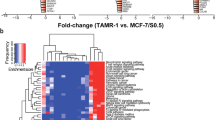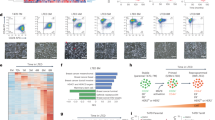Abstract
Development of endocrine resistance in hormone-receptor-positive (HR+ve) subtype and lack of definitive target in triple-negative subtype challenge breast cancer management. Contributing to such endocrine resistance is a protein called CUEDC2. It degrades hormone receptors, estrogen receptor-α (ERα) and progesterone receptor. Higher level of CUEDC2 in ERα+ve breast cancer corresponded to poorer disease prognosis. It additionally influences mitotic progression. However, the crosstalk of these two CUEDC2-driven functions in the outcome of breast cancer remained elusive. We showed that CUEDC2 degrades ERα during mitosis, utilising the mitotic-ubiquitination-machinery. We elucidated the importance of mitosis-specific phosphorylation of CUEDC2 in this process. Furthermore, upregulated CUEDC2 overrode mitotic arrest, increasing aneuploidy. Finally, recruiting a prospective cohort of breast cancer, we found significantly upregulated CUEDC2 in HR-ve cases. Moreover, individuals with higher CUEDC2 levels showed a poorer progression-free-survival. Together, our data confirmed that CUEDC2 up-regulation renders ERα+ve malignancies to behave essentially as HR-ve tumors with the prevalence of aneuploidy. This study finds CUEDC2 as a potential prognostic marker and a therapeutic target in the clinical management of breast cancer.
This is a preview of subscription content, access via your institution
Access options
Subscribe to this journal
Receive 12 print issues and online access
$259.00 per year
only $21.58 per issue
Buy this article
- Purchase on Springer Link
- Instant access to full article PDF
Prices may be subject to local taxes which are calculated during checkout







Similar content being viewed by others
References
Sung H, Ferlay J, Siegel RL, Laversanne M, Soerjomataram I, Jemal A, et al. Global Cancer Statistics 2020: GLOBOCAN Estimates of incidence and mortality worldwide for 36 cancers in 185 countries. CA Cancer J Clin. 2021;71:209–49.
Pandit P, Patil R, Palwe V, Gandhe S, Patil R, Nagarkar R. Prevalence of molecular subtypes of breast cancer: A single institutional experience of 2062 patients. Eur J Breast Health. 2020;16:39–43.
Saha Roy S, Vadlamudi RK. Role of estrogen receptor signaling in breast cancer metastasis. Int J Breast Cancer. 2012;2012:654698.
Kumar N, Gulati HK, Sharma A, Heer S, Jassal AK, Arora L, et al. Most recent strategies targeting estrogen receptor alpha for the treatment of breast cancer. Mol Divers. 2021;25:603–24.
Belachew EB, Sewasew DT. Molecular mechanisms of endocrine resistance in estrogen-positive breast cancer. Front Endocrinol (Lausanne). 2021;12:599586.
Pan X, Zhou T, Tai YH, Wang C, Zhao J, Cao Y, et al. Elevated expression of CUEDC2 protein confers endocrine resistance in breast cancer. Nat Med. 2011;17:708–14.
Shih SC, Prag G, Francis SA, Sutanto MA, Hurley JH, Hicke L. A ubiquitin-binding motif required for intramolecular monoubiquitylation, the CUE domain. EMBO J. 2003;22:1273–81.
Man J, Zhang X. CUEDC2: An emerging key player in inflammation and tumorigenesis. Protein Cell. 2011;2:699–703.
Gao YF, Li T, Chang Y, Wang YB, Zhang WN, Li WH, et al. Cdk1-phosphorylated CUEDC2 promotes spindle checkpoint inactivation and chromosomal instability. Nat Cell Biol. 2011;13:924–33.
Lin CY, Strom A, Vega VB, Kong SL, Yeo AL, Thomsen JS, et al. Discovery of estrogen receptor alpha target genes and response elements in breast tumor cells. Genome Biol. 2004;5:R66.
Sabbah M, Courilleau D, Mester J, Redeuilh G. Estrogen induction of the cyclin D1 promoter: Involvement of a cAMP response-like element. Proc Natl Acad Sci USA. 1999;96:11217–22.
Wang C, Mayer JA, Mazumdar A, Fertuck K, Kim H, Brown M, et al. Estrogen induces c-myc gene expression via an upstream enhancer activated by the estrogen receptor and the AP-1 transcription factor. Mol Endocrinol. 2011;25:1527–38.
JavanMoghadam S, Weihua Z, Hunt KK, Keyomarsi K. Estrogen receptor alpha is cell cycle-regulated and regulates the cell cycle in a ligand-dependent fashion. Cell Cycle. 2016;15:1579–90.
Matson DR, Stukenberg PT. Spindle poisons and cell fate: a tale of two pathways. Mol Inter. 2011;11:141–50.
Elmaci I, Altinoz MA, Sari R, Bolukbasi FH. Phosphorylated Histone H3 (PHH3) as a novel cell proliferation marker and prognosticator for meningeal tumors: A short review. Appl Immunohistochem Mol Morphol. 2018;26:627–31.
Watson ER, Brown NG, Peters JM, Stark H, Schulman BA. Posing the APC/C E3 Ubiquitin Ligase to Orchestrate Cell Division. Trends Cell Biol. 2019;29:117–34.
Musacchio A, Salmon ED. The spindle-assembly checkpoint in space and time. Nat Rev Mol Cell Biol. 2007;8:379–93.
Zhou Z, He M, Shah AA, Wan Y. Insights into APC/C: From cellular function to diseases and therapeutics. Cell Div. 2016;11:9.
Encarnacion CA, Ciocca DR, McGuire WL, Clark GM, Fuqua SA, Osborne CK. Measurement of steroid hormone receptors in breast cancer patients on tamoxifen. Breast Cancer Res Treat. 1993;26:237–46.
Shi L, Dong B, Li Z, Lu Y, Ouyang T, Li J, et al. Expression of ER-{alpha}36, a novel variant of estrogen receptor {alpha}, and resistance to tamoxifen treatment in breast cancer. J Clin Oncol. 2009;27:3423–9.
Musgrove EA, Sutherland RL. Biological determinants of endocrine resistance in breast cancer. Nat Rev Cancer. 2009;9:631–43.
Masoud V, Pages G. Targeted therapies in breast cancer: New challenges to fight against resistance. World J Clin Oncol. 2017;8:120–34.
Rani A, Stebbing J, Giamas G, Murphy J. Endocrine resistance in hormone receptor positive breast cancer-from mechanism to therapy. Front Endocrinol (Lausanne). 2019;10:245.
De Amicis F, Thirugnansampanthan J, Cui Y, Selever J, Beyer A, Parra I, et al. Androgen receptor overexpression induces tamoxifen resistance in human breast cancer cells. Breast Cancer Res Treat. 2010;121:1–11.
Lord CJ, Ashworth A. BRCAness revisited. Nat Rev Cancer. 2016;16:110–20.
Vagia E, Mahalingam D, Cristofanilli M. The landscape of targeted therapies in TNBC. Cancers (Basel). 2020;12:916.
Zhou Q, Atadja P, Davidson NE. Histone deacetylase inhibitor LBH589 reactivates silenced estrogen receptor alpha (ER) gene expression without loss of DNA hypermethylation. Cancer Biol Ther. 2007;6:64–9.
Brinkman JA, El-Ashry D. ER re-expression and re-sensitization to endocrine therapies in ER-negative breast cancers. J Mammary Gland Biol Neoplasia. 2009;14:67–78.
Saxena NK, Sharma D. Epigenetic reactivation of estrogen receptor: Promising tools for restoring response to endocrine therapy. Mol Cell Pharm. 2010;2:191–202.
Vesuna F, Lisok A, Kimble B, Domek J, Kato Y, van der Groep P, et al. Twist contributes to hormone resistance in breast cancer by downregulating estrogen receptor-alpha. Oncogene 2012;31:3223–34.
Sarkar S, Ghosh A, Banerjee S, Maity G, Das A, Larson MA, et al. CCN5/WISP-2 restores ER- proportional, variant in normal and neoplastic breast cells and sensitizes triple negative breast cancer cells to tamoxifen. Oncogenesis 2017;6:e340.
Bayliss J, Hilger A, Vishnu P, Diehl K, El-Ashry D. Reversal of the estrogen receptor negative phenotype in breast cancer and restoration of antiestrogen response. Clin Cancer Res. 2007;13:7029–36.
Zhang PJ, Zhao J, Li HY, Man JH, He K, Zhou T, et al. CUE domain containing 2 regulates degradation of progesterone receptor by ubiquitin-proteasome. EMBO J. 2007;26:1831–42.
Vasudevan A, Schukken KM, Sausville EL, Girish V, Adebambo OA, Sheltzer JM. Aneuploidy as a promoter and suppressor of malignant growth. Nat Rev Cancer. 2021;21:89–103.
Ben-David U, Amon A. Context is everything: Aneuploidy in cancer. Nat Rev Genet. 2020;21:44–62.
Carroll JS. Mechanisms of oestrogen receptor (ER) gene regulation in breast cancer. Eur J Endocrinol. 2016;175:R41–9.
Cho JH, Yoon MS, Koo JB, Kim YS, Lee KS, Lee JH, et al. The progesterone receptor as a transcription factor regulates phospholipase D1 expression through independent activation of protein kinase A and Ras during 8-Br-cAMP-induced decidualization in human endometrial stromal cells. Biochem J. 2011;436:181–91.
Acknowledgements
We acknowledge Dr. Gopal C. Kundu, NCCS, Pune, and Prof. Tanya Das, Bose Institute, Kolkata, for cell culture related support.
Funding
This study is supported by Early Career Award, Science & Engineering Research Board (SERB)-Dept. of Science and Technology (DST), Govt of India (File No. ECR/2015/000206) and, Grant-in-Aid, Department of Science & Technology and Biotechnology (DSTBT), Govt. of West Bengal (FST/P/S&T/9G-21/2016), awarded to SN. StR is supported by University Grants Commission- Junior Research Fellowship (UGC Ref. No.:771/ CSIR-UGC NET-2017). SR is the recipient of the ICMR Emeritus Scientist fellowship.
Author information
Authors and Affiliations
Contributions
StR, SS, SR and SN conceptualised the study. StR, SS, PC, KSR, CM performed the experiments. AG and SB provided the clinical samples and data. AR performed the histological evaluation. StR, SS, CM, SN analysed the data. StR and SN wrote the manuscript with input from all the authors.
Corresponding author
Ethics declarations
Conflict of interest
The authors declare no competing interests.
Ethics approval and consent to participate
The study was approved by the institutional ethics committee (IEC SGCCRI REF NO- 2016/3/4/SN/NON-REG/05/02) under regulation of the Indian Council of Medical Research (ICMR).
Additional information
Publisher’s note Springer Nature remains neutral with regard to jurisdictional claims in published maps and institutional affiliations.
Supplementary information
Rights and permissions
About this article
Cite this article
Roy, S., Saha, S., Dhar, D. et al. Molecular crosstalk between CUEDC2 and ERα influences the clinical outcome by regulating mitosis in breast cancer. Cancer Gene Ther 29, 1697–1706 (2022). https://doi.org/10.1038/s41417-022-00494-x
Received:
Revised:
Accepted:
Published:
Issue Date:
DOI: https://doi.org/10.1038/s41417-022-00494-x



